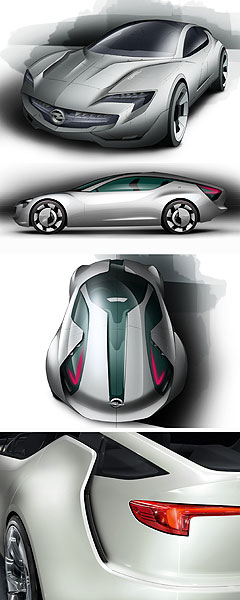Future models - Vauxhall - Flextreme GT/EFirst look: GM creates an Ampera-based GTAero hero: Sleek Flextreme GT/E has a drag coefficient of 0.22Cd and neat aero features, such as side spoilers that appear at higher speeds. Stunning Opel/Vauxhall concept combines Ampera plug-in tech with new GT body19 Feb 2010 By TERRY MARTIN A YEAR after unveiling the Opel/Vauxhall version of its global plug-in hybrid car at the Geneva motor show – dubbed the Ampera, rather than Volt – General Motors will show a dramatic new five-door coupe concept based on the same technology. A demonstration of GM’s new-found, multi-billion-dollar commitment to overhauling its European operations after it decided not to sell them off last year to a consortium led by car parts giant Magna International, the so-called Flextreme GT/E shows a new design direction and suggests a possible new GT flagship model for Opel/Vauxhall. It also underscores GM’s intention to broaden the application of its plug-in hybrid technology past the Ampera/Volt small-car twins to medium and large-sized vehicles, as well as providing an insight into some the American auto giant’s advanced design and engineering work in improving aerodynamics. The company describes the strategy underpinning the Flextreme GT/E concept “e-mobility unlimited” which is a reference to its plan to adapt the plug-in hybrid powertrain “to vehicles across all market segments”. In other words, “size really doesn’t matter when it comes to driving a car with zero CO2 emissions”. The sleek, slippery shape of the concept has a drag coefficient of just 0.22Cd, which GM claims enables it to reach a maximum speed of more than 200km/h – at least 40km/h more than the Ampera – with the now-familiar range-extending front-drive E-REV powertrain, which combines a 120kW/370Nm electric motor (and 16kWh 350-volt lithium-ion battery pack) with a 53kW 1.4-litre four-cylinder engine.  Other performance figures are similar to the Ampera/Volt, which is impressive considering the larger size and, presumably, increased weight of the Flextreme GT/E. Other performance figures are similar to the Ampera/Volt, which is impressive considering the larger size and, presumably, increased weight of the Flextreme GT/E.According to GM, the GT concept has a 60km range in pure-electric mode, extending to more than 500km with the petrol engine involved. Estimated CO2 emissions on the EU combined cycle test are just 40g/km, while 0-100km/h acceleration is listed at less than 9.0 seconds. Recharging via a 230-volt outlet to full capacity is said to take less than three hours. For the designers, the stand-out visual features on the concept include its low, wide stance, wing-shaped front and rear LED light clusters, the distinctive nose and grille, ‘floating’ C-pillars and the muscular, sculptured bodywork. A teaser photograph of the concept issued earlier this month centred on a new, slimmer interpretation of the trapezoidal grille with a prominent wing-shaped chrome bar carrying a large Vauxhall/Opel emblem – which also doubles as a socket for charging the battery pack. There are rear-hinged doors, which GM describes as an evolution of the FlexDoors concept from the new-generation Meriva, and other concept-car favourites as camera pods in lieu of wing mirrors and light sensors replacing traditional doorhandles. Of particular interest is the coupe-like rear-end styling, which is accentuated by the steeply raked tailgate. As seen on the Insignia Sports Tourer, the tailgate has a wraparound design for improved boot access, plus a convex deep glass screen designed to improve airflow. Other aerodynamic reference points include a flat and enclosed undercarriage, narrow 21-inch alloy wheels, low-rolling-resistance 195/45-section tyres and the compact frontal area which includes a small front intake that improves airflow around the nose of the car. GM’s designers have also explored the potential for “active shape shifting” with 350mm-long side spoilers that, at speeds above 48km/h, extend along the body from the air extraction slot behind each rear wheelarch. The spoilers are designed to guide higher-speed airflow around the rear corners of the vehicle, further reducing turbulence. The four-seater “upper mid-size” GT’s sporting stance and potential as a long and relatively spacious flagship are evident in its 1308mm height, 1871mm width (plus 1600mm front/rear track), 4762mm length and 2900mm wheelbase. No weight figures are given, but GM has emphasised the mass-reduction measures across the car, including the use of lightweight carbon composite outer panels, polycarbonate window glazing and aluminium structural components. Combined, these are said to offer a 40 per cent weight saving, further contributing to an increased driving range.  Read more |
Click to shareVauxhall modelsMotor industry news |
















Facebook Twitter Instagram